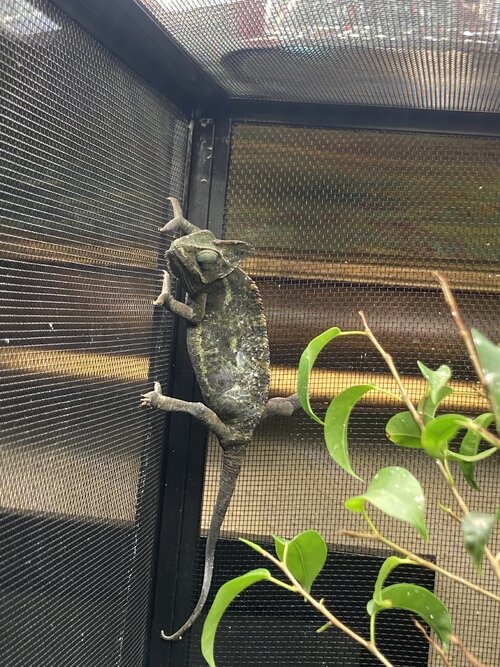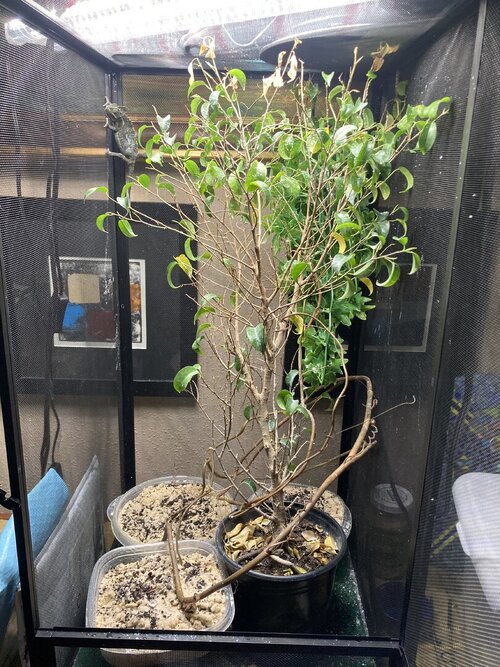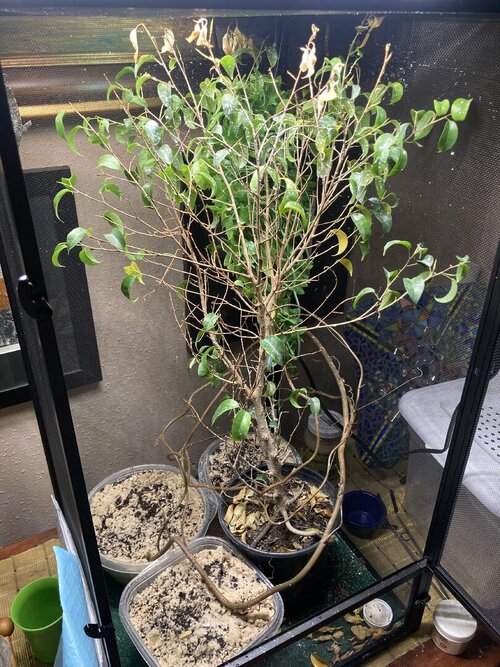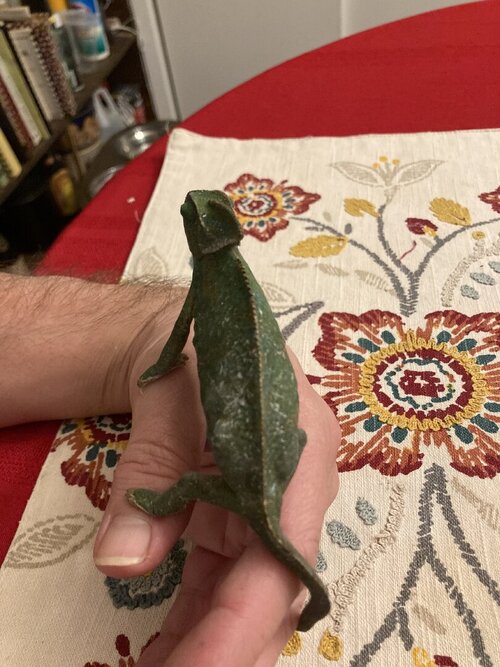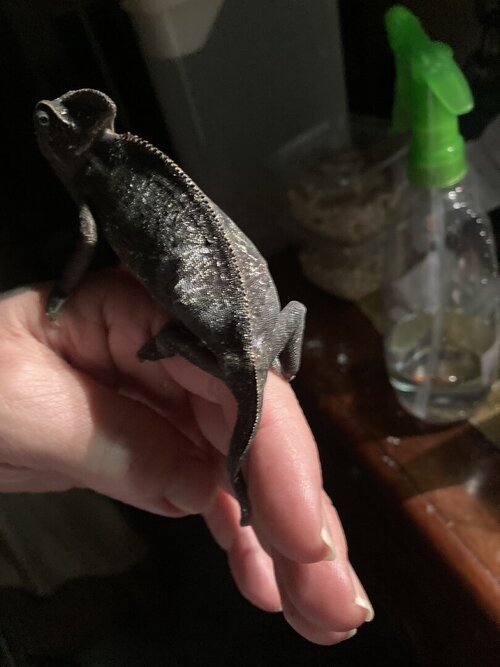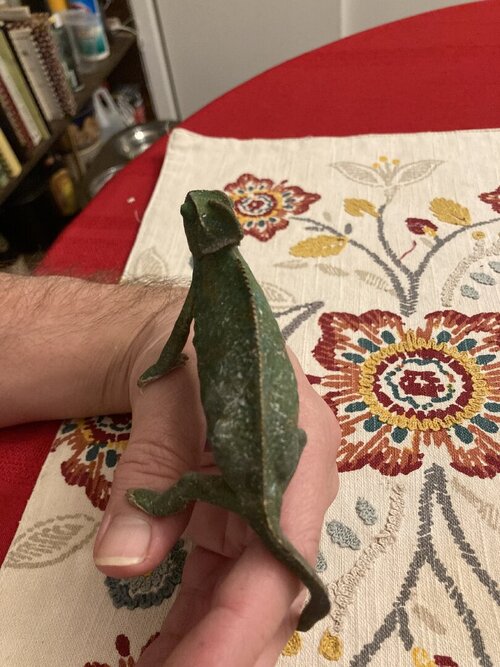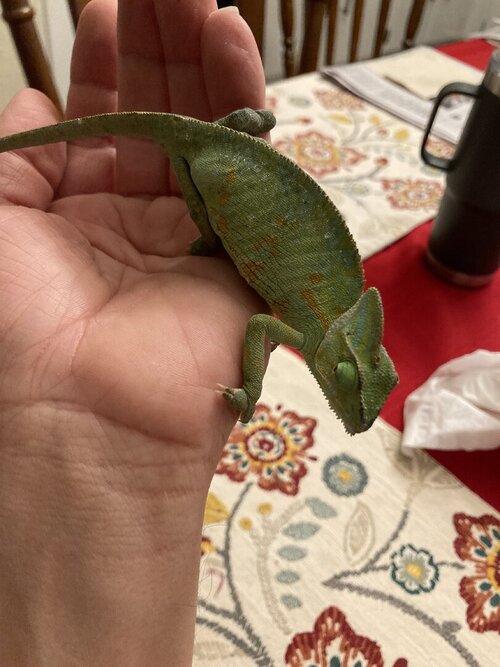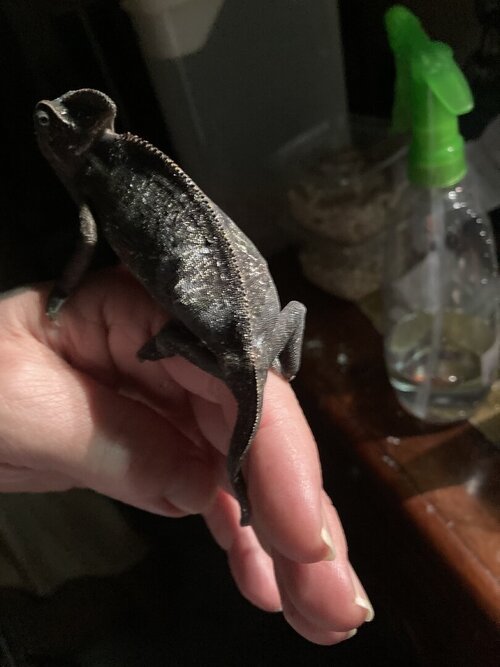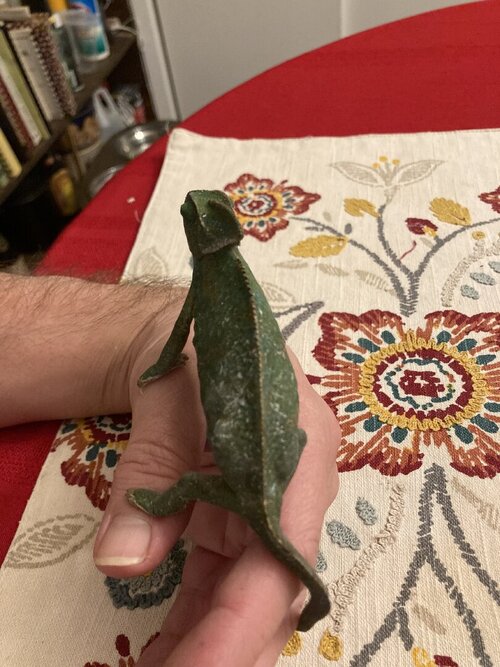Hello, new here and I just bought a female veiled and have had her three weeks now. First time having a female. My girl is spending a lot of time at the bottom crawling around. I assumed she’s looking to nest. Didn’t think this would happen so fast. I think she’s about 3-4 months. I have a sand dish in her cage and she crawls down to the bottom surface passing the dish so I put two more dishes of sand 4-5 inches deep. One is only a couple inches deep. She crawls right passed it to the floor. 3/4 of the floor are dishes of sand. I’ve never dealt with the egg laying process before I’m doing everything I’ve read about and watched on yt videos. Everyday all day she’s at the bottom crawling around. She wants nothing to do with me either. I’m in Louisiana. Can anybody help with any advice please?
Navigation
Install the app
How to install the app on iOS
Follow along with the video below to see how to install our site as a web app on your home screen.
Note: This feature may not be available in some browsers.
More options
You are using an out of date browser. It may not display this or other websites correctly.
You should upgrade or use an alternative browser.
You should upgrade or use an alternative browser.
Egg laying
- Thread starter Frank J
- Start date
MissSkittles
Chameleon Enthusiast
Hi and welcome. So sorry that your post seems to have been over looked. I’d be more than happy to help you figure out what’s going on with your sweet girl. First I’d really like if you could post some pics (prefer not thru the screen) of her and her entire enclosure.
Thank you for replying. She has some white calcium powder on her so that’s what the white is. I added a grow light recently to help the ficcus plant. Would that affect her at all? I have done that before with past chameleons. I’m also wondering if she’s looking for escape. I don’t know. Tell me what you think
Attachments
How much do you feed her in a week and how often?
What supplements do you use and how heavily and how often? I’m particularly interested in the vitamin D3 and form of vitamin A and calcium and phos. What do you feed to the insects?
Whats the basking temperature?
Attachments
MissSkittles
Chameleon Enthusiast
I’m not sure if her colors/patterns are from being stressed or not, so it’s hard to tell but I think she looks older than just a few months. I’m afraid I do see room for improvement in her enclosure, so she very well could be trying to escape. I’m glad that your post has caught the eye of @kinyonga as she is the best and has a wealth of experience. Let’s do a full husbandry review and get all of the needed info at once.Thank you for replying. She has some white calcium powder on her so that’s what the white is. I added a grow light recently to help the ficcus plant. Would that affect her at all? I have done that before with past chameleons. I’m also wondering if she’s looking for escape. I don’t know. Tell me what you think
Copy and paste the following with your answers.
Chameleon Info:
- Your Chameleon - The species, sex, and age of your chameleon. How long has it been in your care?
- Handling - How often do you handle your chameleon?
- Feeding - What are you feeding your cham? What amount? What is the schedule? How are you gut-loading your feeders?
- Supplements - What brand and type of calcium and vitamin products are you dusting your feeders with and what is the schedule?
- Watering - What kind of watering technique do you use? How often and how long to you mist? Do you see your chameleon drinking?
- Fecal Description - Briefly note colors and consistency from recent droppings. Has this chameleon ever been tested for parasites?
- History - Any previous information about your cham that might be useful to others when trying to help you.
Cage Info:
- Cage Type - Describe your cage (Glass, Screen, Combo?) What are the dimensions?
- Lighting - What brand, model, and types of lighting are you using? What is your daily lighting schedule?
- Temperature - What temp range have you created (cage floor to basking spot)? Lowest overnight temp? How do you measure these temps?
- Humidity - What are your humidity levels? How are you creating and maintaining these levels? What do you use to measure humidity?
- Plants - Are you using live plants? If so, what kind?
- Placement - Where is your cage located? Is it near any fans, air vents, or high traffic areas? At what height is the top of the cage relative to your room floor?
- Location - Where are you geographically located?
Current Problem - The current problem you are concerned about.
--------------
Please Note:
- The more details you provide the better and more accurate help you will receive.
- Photos can be very helpful.
So far I’ll put about 3 crickets and reptile calcium with d3 powder and a couple super worms and they are gone, she hasn’t eaten anything in 2 or 3 days that I have notice. Maybe a worm bc I can’t find it. The 2 lights came with the cage along with the calcium powder. Imisther 2-3 times daily. I don’t have my thermometer due not being able to affix it to the cage yet bc it’s suction cups but it’s not too hot and she can move away from the lights if she wants. There are bump on both sides of her hind legs so I thing she has eggs but she’s so young, however she’s bypassing the sand. I’m worriedHow much do you feed her in a week and how often?
What supplements do you use and how heavily and how often? I’m particularly interested in the vitamin D3 and form of vitamin A and calcium and phos. What do you feed to the insects?
Whats the basking temperature?
MissSkittles
Chameleon Enthusiast
If you’re using anything with D3 in it more than one feeding every other week, she’s getting too much. It sounds that you bought the chameleon kit. If so, we definitely need to do the full husbandry review and help get things improved.So far I’ll put about 3 crickets and reptile calcium with d3 powder and a couple super worms and they are gone, she hasn’t eaten anything in 2 or 3 days that I have notice. Maybe a worm bc I can’t find it. The 2 lights came with the cage along with the calcium powder. Imisther 2-3 times daily. I don’t have my thermometer due not being able to affix it to the cage yet bc it’s suction cups but it’s not too hot and she can move away from the lights if she wants. There are bump on both sides of her hind legs so I thing she has eggs but she’s so young, however she’s bypassing the sand. I’m worried
I’m not sure if her colors/patterns are from being stressed or not, so it’s hard to tell but I think she looks older than just a few months. I’m afraid I do see room for improvement in her enclosure, so she very well could be trying to escape. I’m glad that your post has caught the eye of @kinyonga as she is the best and has a wealth of experience. Let’s do a full husbandry review and get all of the needed info at once.
Copy and paste the following with your answers.
Chameleon Info:
- Your Chameleon - The species, sex, and age of your chameleon. How long has it been in your care?
- Handling - How often do you handle your chameleon?
- Feeding - What are you feeding your cham? What amount? What is the schedule? How are you gut-loading your feeders?
- Supplements - What brand and type of calcium and vitamin products are you dusting your feeders with and what is the schedule?
- Watering - What kind of watering technique do you use? How often and how long to you mist? Do you see your chameleon drinking?
- Fecal Description - Briefly note colors and consistency from recent droppings. Has this chameleon ever been tested for parasites?
- History - Any previous information about your cham that might be useful to others when trying to help you.
Cage Info:
- Cage Type - Describe your cage (Glass, Screen, Combo?) What are the dimensions?
- Lighting - What brand, model, and types of lighting are you using? What is your daily lighting schedule?
- Temperature - What temp range have you created (cage floor to basking spot)? Lowest overnight temp? How do you measure these temps?
- Humidity - What are your humidity levels? How are you creating and maintaining these levels? What do you use to measure humidity?
- Plants - Are you using live plants? If so, what kind?
- Placement - Where is your cage located? Is it near any fans, air vents, or high traffic areas? At what height is the top of the cage relative to your room floor?
- Location - Where are you geographically located?
Current Problem - The current problem you are concerned about.
--------------
Please Note:
- The more details you provide the better and more accurate help you will receive.
- Photos can be very helpful.
The cage set up has been moved around since I added the sand and now the ficcus is dropping leaves but I have another one to change it out. She was completely content until 3 days ago.If you’re using anything with D3 in it more than one feeding every other week, she’s getting too much. It sounds that you bought the chameleon kit. If so, we definitely need to do the full husbandry review and help get things improved.
She looks older than 3 or 4 months to me too. She does look “eggy” to me too.
The insects should be Dusted with calcium powder lightly at all feedings but two a month. On those two remaining feedings a vitamin powder with D3 and a source of prEformed vitamin A should be dusted on them lightly.
How many insects total does she get in a week?
Is the sand moist enough to hold a tunnel when you dig in it?
She seems to be having a bit of trouble with her shed too…if what I’m seeing is old shed and not the start of a new shed.
The insects should be Dusted with calcium powder lightly at all feedings but two a month. On those two remaining feedings a vitamin powder with D3 and a source of prEformed vitamin A should be dusted on them lightly.
How many insects total does she get in a week?
Is the sand moist enough to hold a tunnel when you dig in it?
She seems to be having a bit of trouble with her shed too…if what I’m seeing is old shed and not the start of a new shed.
Copy and paste the following with your answers.She looks older than 3 or 4 months to me too. She does look “eggy” to me too.
The insects should be Dusted with calcium powder lightly at all feedings but two a month. On those two remaining feedings a vitamin powder with D3 and a source of prEformed vitamin A should be dusted on them lightly.
How many insects total does she get in a week?
Is the sand moist enough to hold a tunnel when you dig in it?
She seems to be having a bit of trouble with her shed too…if what I’m seeing is old shed and not the start of a new shed.
Chameleon Info:
• Your Chameleon - The species, sex, and age of your chameleon. How long has it been in your care? Female veiled. I was told 3-4 months possibly 6.
Ive had her since Dec. 10th
• Handling - How often do you handle your chameleon? Only three times
• Feeding - What are you feeding your cham? Crickets and super worms What amount? About 3 medium sized crickets and 1-2 worms a day. What is the schedule? Morning and late afternoon.How are you gut-loading your feeders? Dry cricket food, carrots and zucchini and squash.
• Supplements - What brand and type of calcium and vitamin products are you dusting your feeders with and what is the schedule? Repti calcium with d3
• Watering - What kind of watering technique do you use? How often and how long to you mist? I mist her a few times throughout the day. Do you see your chameleon drinking? Yes
• Fecal Description - Briefly note colors and consistency from recent droppings. Looks normal as past chameleons I’ve had. Has this chameleon ever been tested for parasites? No
• History - Any previous information about your cham that might be useful to others when trying to help you. Unsure. I have had several chameleons in the past. My first female
Cage Info:
• Cage Type - Describe your cage (Glass, Screen, Combo?) What are the dimensions? Screen 16 x 30
• Lighting - What brand, model, and types of lighting are you using? What is your daily lighting schedule? Lights came with kit, Morning to evening
• Temperature - What temp range have you created (cage floor to basking spot)? Lowest overnight temp? How do you measure these temps?
• Humidity - What are your humidity levels? How are you creating and maintaining these levels? Misting What do you use to measure humidity?
• Plants - Are you using live plants? If so, what kind? Ficcus and fake vines
• Placement - Where is your cage located? Bedroom Is it near any fans, air vents, or high traffic areas? No At what height is the top of the cage relative to your room floor? 5feet
• Location - Where are you geographically located? Louisiana
Current Proble
m
- The current problem you are concerned about.
Her becoming egg bound and not going to the sand
She’s not shedding but it does look like it. She has some white lines and looks like skin. So far no loose skin. She might be trying to escape when I tried to hold her while moving things around. She got really scared. I try to leave her alone and she prefers that. Once out of the cage she’s fine and colors look normal. This was ten minutes ago. Her natural color but she is also dark
Attachments
Copy and paste the following with your answers.
Chameleon Info:
• Your Chameleon - The species, sex, and age of your chameleon. How long has it been in your care? Female veiled. I was told 3-4 months possibly 6.
Ive had her since Dec. 10th
• Handling - How often do you handle your chameleon? Only three times
• Feeding - What are you feeding your cham? Crickets and super worms What amount? About 3 medium sized crickets and 1-2 worms a day. What is the schedule? Morning and late afternoon.How are you gut-loading your feeders? Dry cricket food, carrots and zucchini and squash.
• Supplements - What brand and type of calcium and vitamin products are you dusting your feeders with and what is the schedule? Repti calcium with d3
• Watering - What kind of watering technique do you use? How often and how long to you mist? I mist her a few times throughout the day. Do you see your chameleon drinking? Yes
• Fecal Description - Briefly note colors and consistency from recent droppings. Looks normal as past chameleons I’ve had. Has this chameleon ever been tested for parasites? No
• History - Any previous information about your cham that might be useful to others when trying to help you. Unsure. I have had several chameleons in the past. My first female
Cage Info:
• Cage Type - Describe your cage (Glass, Screen, Combo?) What are the dimensions? Screen 16 x 30
• Lighting - What brand, model, and types of lighting are you using? What is your daily lighting schedule? Lights came with kit, Morning to evening
• Temperature - What temp range have you created (cage floor to basking spot)? Lowest overnight temp? How do you measure these temps?
• Humidity - What are your humidity levels? How are you creating and maintaining these levels? Misting What do you use to measure humidity?
• Plants - Are you using live plants? If so, what kind? Ficcus and fake vines
• Placement - Where is your cage located? Bedroom Is it near any fans, air vents, or high traffic areas? No At what height is the top of the cage relative to your room floor? 5feet
• Location - Where are you geographically located? Louisiana
Current Proble
m
- The current problem you are concerned about.
Her becoming egg bound and not going to the sand
Sorry I sent the photo to someone else or did I? These threads are new to me. I apologize. Here it isCan you show a photo with her right leg in it please?
Attachments
MissSkittles
Chameleon Enthusiast
Great! Give me a bit of time and I’ll have a full review for you. 
MissSkittles
Chameleon Enthusiast
I tend to talk a lot, so will split this into two parts.
Chameleon Info:
• Your Chameleon - The species, sex, and age of your chameleon. How long has it been in your care? Female veiled. I was told 3-4 months possibly 6. She definitely is older than 3-4 months. She’s got her big girl colors, so she’s definitely at least 6 months old.
Ive had her since Dec. 10th
• Handling - How often do you handle your chameleon? Only three times Our beautiful veiled ladies aren’t so keen on being handled. You will want to work on building trust with her though. This is a great blog on that. https://www.chameleonforums.com/blogs/building-trust-with-your-chameleon.2396/
• Feeding - What are you feeding your cham? Crickets and super worms What amount? About 3 medium sized crickets and 1-2 worms a day. Crickets are a good staple but you’ll want some variety. Attaching some graphics below to help guide you. Superworms are quite fatty and should be given in moderation as treats only. Right now I’d say to just give 5 feeders daily in the morning. She‘s still growing and needs the nutrition, but she’s also of reproductive age and the more you feed, the more eggs she’ll produce. After she lays her first clutch of eggs, you’ll want to reduce her feedings to 3-4 feeders three days a week (plus treats). What is the schedule? Morning and late afternoon. It’s best to feed just once and early in the day to give time for her to bask and digest. How are you gut-loading your feeders? Dry cricket food, carrots and zucchini and squash. Pretty good. You could try adding some greens or variety. It’s important to keep your insect feeders as healthy as possible so that they’ll be more nutritious.
• Supplements - What brand and type of calcium and vitamin products are you dusting your feeders with and what is the schedule? Repti calcium with d3 If you’ve been using this more than once every other week, then she’s been getting too much D3. When given in supplement form, D3 can build up to toxic levels. Stop using this for at least two weeks. Repticalcium is good, but get the one without D3 and use that lightly dusted on every feeding (except those when you use a different supplement). The one with D3 is to be given for one feeding every other week. Then you need a good multivitamin, which will also be given once every other week (alternate with the D3). Reptivite without D3 is a good supplement and contains proformed vitamin A, which is good for eye health. So, to summarize the schedule, calcium without D3 every feeding. On the 1st and 14th of every month, use the calcium with D3 and on the 7th and 21st of every month, use the ReptiVite without D3.
At the risk of confusing things to make your supplement schedule easier, instead of using separate D3 and multivitamin, you can use a combination product such as ReptiVite with D3 or Repashy calcium plus LoD at one feeding every other week.
• Watering - What kind of watering technique do you use? How often and how long to you mist? I mist her a few times throughout the day. Do you see your chameleon drinking? Yes It’s best to mist/spray for at least two minutes before lights go on and off. If needed, you can add a one minute misting during the day or use a dripper for just 15-20 minutes. Go by the color of urates to determine her hydration status.
• Fecal Description - Briefly note colors and consistency from recent droppings. Looks normal as past chameleons I’ve had. Has this chameleon ever been tested for parasites? No It’s always a good idea to have a fecal check for parasites.
• History - Any previous information about your cham that might be useful to others when trying to help you. Unsure. I have had several chameleons in the past. My first female I’ve only started with chameleons a few years ago and have noticed changes in husbandry standards. As we learn more about them, the husbandry changes and improves. Also, as technology continues to grow, better products become available.


Chameleon Info:
• Your Chameleon - The species, sex, and age of your chameleon. How long has it been in your care? Female veiled. I was told 3-4 months possibly 6. She definitely is older than 3-4 months. She’s got her big girl colors, so she’s definitely at least 6 months old.
Ive had her since Dec. 10th
• Handling - How often do you handle your chameleon? Only three times Our beautiful veiled ladies aren’t so keen on being handled. You will want to work on building trust with her though. This is a great blog on that. https://www.chameleonforums.com/blogs/building-trust-with-your-chameleon.2396/
• Feeding - What are you feeding your cham? Crickets and super worms What amount? About 3 medium sized crickets and 1-2 worms a day. Crickets are a good staple but you’ll want some variety. Attaching some graphics below to help guide you. Superworms are quite fatty and should be given in moderation as treats only. Right now I’d say to just give 5 feeders daily in the morning. She‘s still growing and needs the nutrition, but she’s also of reproductive age and the more you feed, the more eggs she’ll produce. After she lays her first clutch of eggs, you’ll want to reduce her feedings to 3-4 feeders three days a week (plus treats). What is the schedule? Morning and late afternoon. It’s best to feed just once and early in the day to give time for her to bask and digest. How are you gut-loading your feeders? Dry cricket food, carrots and zucchini and squash. Pretty good. You could try adding some greens or variety. It’s important to keep your insect feeders as healthy as possible so that they’ll be more nutritious.
• Supplements - What brand and type of calcium and vitamin products are you dusting your feeders with and what is the schedule? Repti calcium with d3 If you’ve been using this more than once every other week, then she’s been getting too much D3. When given in supplement form, D3 can build up to toxic levels. Stop using this for at least two weeks. Repticalcium is good, but get the one without D3 and use that lightly dusted on every feeding (except those when you use a different supplement). The one with D3 is to be given for one feeding every other week. Then you need a good multivitamin, which will also be given once every other week (alternate with the D3). Reptivite without D3 is a good supplement and contains proformed vitamin A, which is good for eye health. So, to summarize the schedule, calcium without D3 every feeding. On the 1st and 14th of every month, use the calcium with D3 and on the 7th and 21st of every month, use the ReptiVite without D3.
At the risk of confusing things to make your supplement schedule easier, instead of using separate D3 and multivitamin, you can use a combination product such as ReptiVite with D3 or Repashy calcium plus LoD at one feeding every other week.
• Watering - What kind of watering technique do you use? How often and how long to you mist? I mist her a few times throughout the day. Do you see your chameleon drinking? Yes It’s best to mist/spray for at least two minutes before lights go on and off. If needed, you can add a one minute misting during the day or use a dripper for just 15-20 minutes. Go by the color of urates to determine her hydration status.
• Fecal Description - Briefly note colors and consistency from recent droppings. Looks normal as past chameleons I’ve had. Has this chameleon ever been tested for parasites? No It’s always a good idea to have a fecal check for parasites.
• History - Any previous information about your cham that might be useful to others when trying to help you. Unsure. I have had several chameleons in the past. My first female I’ve only started with chameleons a few years ago and have noticed changes in husbandry standards. As we learn more about them, the husbandry changes and improves. Also, as technology continues to grow, better products become available.
MissSkittles
Chameleon Enthusiast
Cage Info:
• Cage Type - Describe your cage (Glass, Screen, Combo?) What are the dimensions? Screen 16 x 30 This is too small for an adult. The minimum is 2x2x4’ and if you can go larger than that, do it. I have mine in double sized enclosures and enjoy seeing how they use the space. This is one way to double their space. https://chameleonacademy.com/double-wide-chameleon-cage-project/
• Lighting - What brand, model, and types of lighting are you using? What is your daily lighting schedule? Lights came with kit, Morning to evening This is perhaps one of the biggest problems with the chameleon kit…the uvb isn’t adequate. The screw in uvb bulbs provide the levels needed, but only at a distance of 2-3” and that close, you’re risking burns. The standard is a linear T5HO fixture with either a ReptiBreeze 5.0 or Arcadia 6%. Then you want the basking area to be around 8-9” below the lights for optimal uvb levels. Running a 12 hour on/off cycle is perfect and very easily maintained with an inexpensive timer.
• Temperature - What temp range have you created (cage floor to basking spot)? Lowest overnight temp? How do you measure these temps? Having an accurate thermometer is essential. Digital with a probe end is great. Many use ‘smart’ products that they can monitor on their phone. Adding a temp gun is nice to measure surface temps throughout the enclosure. Just avoid the round analog as those are notoriously inaccurate. For an adult female, you want to maintain a basking temp of 80. This, along with diet helps reduce the amount and frequency of eggs produced. At night, it’s ideal to have a significant drop in temp and veileds can handle temps as low the 50’s - but aim for the 60’s.
• Humidity - What are your humidity levels? How are you creating and maintaining these levels? Misting What do you use to measure humidity? This too is important to measure. Too high and you could risk not only poor shedding, but respiratory infection. Too low and again, poor shedding and increased potential for eye issues. The ideal daytime range is between 30-50% for veileds. If you are able to attain/maintain a night time temp below at least 68, you will want to add a cool mist humidifier/fogger and boost humidity as high as you can. This simulates the natural hydration gotten in the wild thru fog.
• Plants - Are you using live plants? If so, what kind? Ficcus and fake vines You only want safe live plants. Veileds (and especially the girls) will eat their plants, so it’s important that they be clean, safe and real. It only takes one nibble of a fake leaf to cause a bowel obstruction. I hang my fake plants on the outside of the enclosure to provide more sense of privacy. https://chameleonacademy.com/plants/ Live plants will also help maintain proper humidity levels and provide little pockets of humidity that your cham can opt to be in.
• Placement - Where is your cage located? Bedroom Is it near any fans, air vents, or high traffic areas? No At what height is the top of the cage relative to your room floor? 5feet Ok, not bad. Being arboreal, height = safety.
• Location - Where are you geographically located? Louisiana
Current Proble
m
- The current problem you are concerned about.
Her becoming egg bound and not going to the sand I’m going to add a separate post on this…I did tell you I talk a lot. I do want to add here though that you want to add lots of branches and vines - little chameleon roads - for your pretty girl to travel on. Use a variety of thickness to properly exercise the mitten feet. Provide areas where she can take shade from the lights or hide in. These are a couple that I’ve set up. One is using Dragon Ledges, which are awesome. https://dragonstrand.com/dragon-ledges/ The other is using plastic garden trellis that is secured with thin wires to the frame of the enclosure. You can also see how my lights are set up. I do use the double dome, but just one side with my basking light. Occasionally if needed, I’ll put a plant bulb in the other side. I prefer the big 70w Sansi grow light https://www.amazon.com/gp/product/B07TKKG8Q3/ref=ppx_yo_dt_b_search_asin_title?ie=UTF8&psc=1 and you can see how bright it is in the first pic.
I do want to add here though that you want to add lots of branches and vines - little chameleon roads - for your pretty girl to travel on. Use a variety of thickness to properly exercise the mitten feet. Provide areas where she can take shade from the lights or hide in. These are a couple that I’ve set up. One is using Dragon Ledges, which are awesome. https://dragonstrand.com/dragon-ledges/ The other is using plastic garden trellis that is secured with thin wires to the frame of the enclosure. You can also see how my lights are set up. I do use the double dome, but just one side with my basking light. Occasionally if needed, I’ll put a plant bulb in the other side. I prefer the big 70w Sansi grow light https://www.amazon.com/gp/product/B07TKKG8Q3/ref=ppx_yo_dt_b_search_asin_title?ie=UTF8&psc=1 and you can see how bright it is in the first pic.


• Cage Type - Describe your cage (Glass, Screen, Combo?) What are the dimensions? Screen 16 x 30 This is too small for an adult. The minimum is 2x2x4’ and if you can go larger than that, do it. I have mine in double sized enclosures and enjoy seeing how they use the space. This is one way to double their space. https://chameleonacademy.com/double-wide-chameleon-cage-project/
• Lighting - What brand, model, and types of lighting are you using? What is your daily lighting schedule? Lights came with kit, Morning to evening This is perhaps one of the biggest problems with the chameleon kit…the uvb isn’t adequate. The screw in uvb bulbs provide the levels needed, but only at a distance of 2-3” and that close, you’re risking burns. The standard is a linear T5HO fixture with either a ReptiBreeze 5.0 or Arcadia 6%. Then you want the basking area to be around 8-9” below the lights for optimal uvb levels. Running a 12 hour on/off cycle is perfect and very easily maintained with an inexpensive timer.
• Temperature - What temp range have you created (cage floor to basking spot)? Lowest overnight temp? How do you measure these temps? Having an accurate thermometer is essential. Digital with a probe end is great. Many use ‘smart’ products that they can monitor on their phone. Adding a temp gun is nice to measure surface temps throughout the enclosure. Just avoid the round analog as those are notoriously inaccurate. For an adult female, you want to maintain a basking temp of 80. This, along with diet helps reduce the amount and frequency of eggs produced. At night, it’s ideal to have a significant drop in temp and veileds can handle temps as low the 50’s - but aim for the 60’s.
• Humidity - What are your humidity levels? How are you creating and maintaining these levels? Misting What do you use to measure humidity? This too is important to measure. Too high and you could risk not only poor shedding, but respiratory infection. Too low and again, poor shedding and increased potential for eye issues. The ideal daytime range is between 30-50% for veileds. If you are able to attain/maintain a night time temp below at least 68, you will want to add a cool mist humidifier/fogger and boost humidity as high as you can. This simulates the natural hydration gotten in the wild thru fog.
• Plants - Are you using live plants? If so, what kind? Ficcus and fake vines You only want safe live plants. Veileds (and especially the girls) will eat their plants, so it’s important that they be clean, safe and real. It only takes one nibble of a fake leaf to cause a bowel obstruction. I hang my fake plants on the outside of the enclosure to provide more sense of privacy. https://chameleonacademy.com/plants/ Live plants will also help maintain proper humidity levels and provide little pockets of humidity that your cham can opt to be in.
• Placement - Where is your cage located? Bedroom Is it near any fans, air vents, or high traffic areas? No At what height is the top of the cage relative to your room floor? 5feet Ok, not bad. Being arboreal, height = safety.
• Location - Where are you geographically located? Louisiana
Current Proble
m
- The current problem you are concerned about.
Her becoming egg bound and not going to the sand I’m going to add a separate post on this…I did tell you I talk a lot.
MissSkittles
Chameleon Enthusiast
Now to go over egg laying. @kinyonga is the best to help you determine if your girl is egg bound or not and guide you. I’m just going to give you info about setting up the lay bin and generic details.
Before becoming ‘with egg’ or gravid, our lovely girls will put on their best and brightest colors and become very restless in their hunt for a handsome boy. For up to a few weeks, this is their obsession. After they calm down and return to their normal activity levels, they begin to get plump and even lumpy as the eggs are developing. Their colors will change and usually darken. Often the changes can be subtle. This first girl only had her dots darken when gravid.


This girl has usually got just patterns, but got all bright when sneaking a peek at my male. Then she darkens all over and her patterns start to merge when gravid.


Anywhere from about 30 days after her receptive period ends, she can be ready to lay eggs. If you are following the regimen to reduce laying/egg production, she may go thru the entire process (even gaining weight) but never lay. You need to be prepared though and keep a lay bin in her enclosure all the time, periodically checking to make sure it’s in good shape. My girls and seemingly some others prefer larger bins of at least 12” long and wide…deep too if possible. This is what I use and I fill it to about 5-6” deep with washed play sand. It needs to be kept moist enough to hold a tunnel without collapsing. To prevent it from becoming a bin of mud, you’ll want to drill some tiny drain holes in the bottom. Once the bin is set in place, it won’t leak sand. Make sure to provide a couple of stable ways in and out of the bin.


One morning you won’t see your girl in her usual spot and will find she’s in her bin and digging! Try to make sure she doesn’t see you. You’ll want to cover the bottom half of your enclosure with a light sheet. I use an old one that I make peek holes in so I can monitor my girls without them seeing me. Hopefully you’ve got an automatic mister. If not, you can set some ice cubes on top of the enclosure (just not over the bin). Honestly though, I don’t think they are taking drink breaks. She may dig a few areas until she likes one. Then it’s dig dig dig, all the way to the bottom and usually along one of the sides of the bin. Then she’ll turn around with her head sticking out of the hole and start laying her eggs. Often the whole thing can take a couple of days and she may sleep in her tunnel or may return to her usual sleeping branch. You’ll know she’s done when all of her holes have been fully covered and she’s sitting in her usual basking spot, looking much thinner and quite dirty.
You’ll want to feed and hydrate her very well for the next 2-3 days. Silkworms and hornworms are perfect at this time. Then you return (or start) feeding her 3-4 feeders, 3 days a week plus treats and continue to maintain a basking temp no higher than 80.
My one girl stopped all egg production and laying for three years (until she passed). My other girl has been laying one clutch every year, except she has skipped this past year. I believe it was her continuously sneaking peaks at her forbidden boyfriend that triggered her laying. He passed right around the time of year that she usually has laid. She got to share stares with my new male while I was getting things set up so that may test the theory.
Always be alert for signs that something is wrong. When I switched my girls to bioactive and figured they didn’t need lay bins anymore, my girl spent a week very restless and digging in everything (including her foam wall) but rejecting it all, including a smaller bin of sand. It wasn’t until I put her old big lay bin in that she got right to work. Signs of trouble include not basking/ staying low in the enclosure, lethargy, not eating or drinking (often appetite is reduced as the eggs take up belly space), dropping eggs randomly, blood from anywhere and anything hanging out of the cloaca/vent (prolapse). Always go with your gut feelings too. It helps to know who your exotics vet who has good experience with chameleons is before needing them. It also helps to have an emergency vet fund and even better, pet insurance. With correct husbandry, the risks for egg problems is greatly decreased, but unfortunately is never zero.
I hope all of this has been of some help. Sorry that I talk so much.
Before becoming ‘with egg’ or gravid, our lovely girls will put on their best and brightest colors and become very restless in their hunt for a handsome boy. For up to a few weeks, this is their obsession. After they calm down and return to their normal activity levels, they begin to get plump and even lumpy as the eggs are developing. Their colors will change and usually darken. Often the changes can be subtle. This first girl only had her dots darken when gravid.
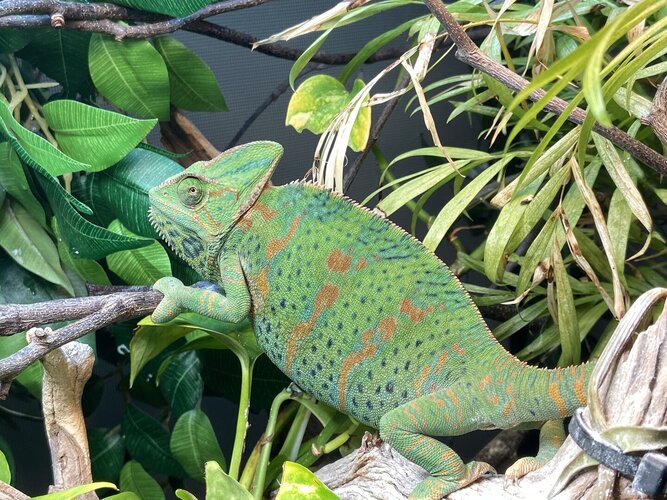
This girl has usually got just patterns, but got all bright when sneaking a peek at my male. Then she darkens all over and her patterns start to merge when gravid.
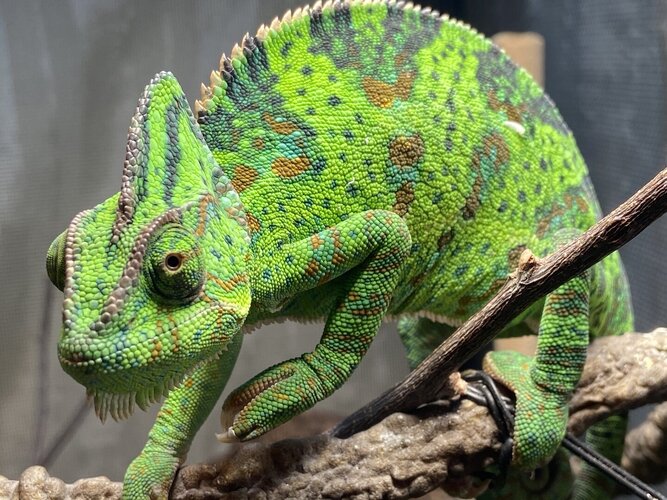
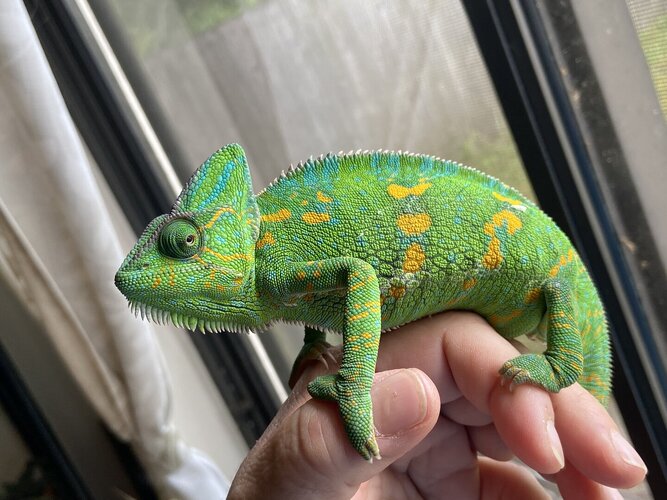
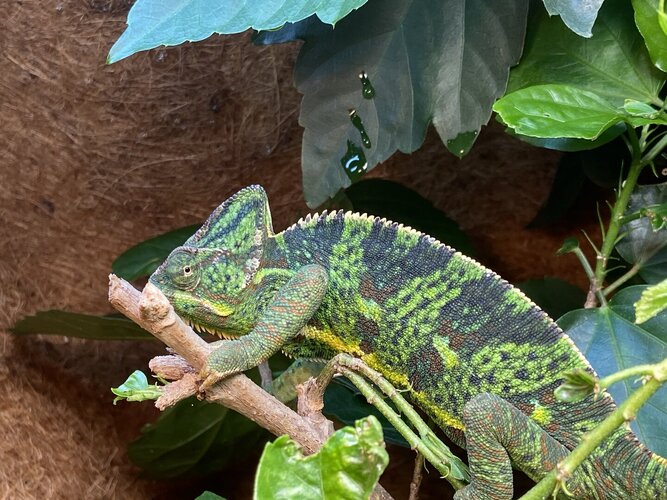
Anywhere from about 30 days after her receptive period ends, she can be ready to lay eggs. If you are following the regimen to reduce laying/egg production, she may go thru the entire process (even gaining weight) but never lay. You need to be prepared though and keep a lay bin in her enclosure all the time, periodically checking to make sure it’s in good shape. My girls and seemingly some others prefer larger bins of at least 12” long and wide…deep too if possible. This is what I use and I fill it to about 5-6” deep with washed play sand. It needs to be kept moist enough to hold a tunnel without collapsing. To prevent it from becoming a bin of mud, you’ll want to drill some tiny drain holes in the bottom. Once the bin is set in place, it won’t leak sand. Make sure to provide a couple of stable ways in and out of the bin.
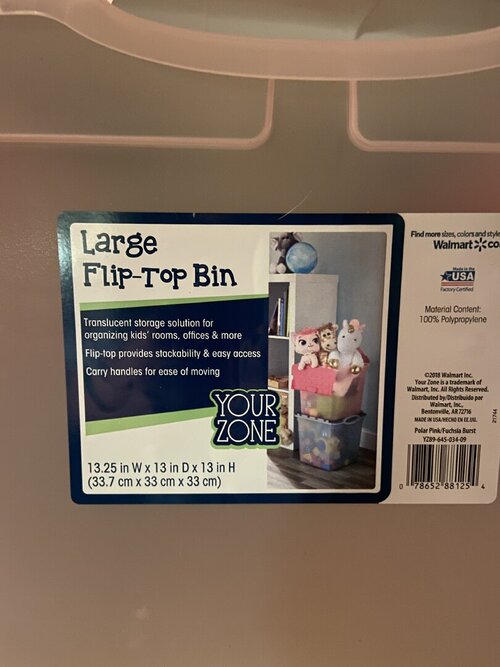

One morning you won’t see your girl in her usual spot and will find she’s in her bin and digging! Try to make sure she doesn’t see you. You’ll want to cover the bottom half of your enclosure with a light sheet. I use an old one that I make peek holes in so I can monitor my girls without them seeing me. Hopefully you’ve got an automatic mister. If not, you can set some ice cubes on top of the enclosure (just not over the bin). Honestly though, I don’t think they are taking drink breaks. She may dig a few areas until she likes one. Then it’s dig dig dig, all the way to the bottom and usually along one of the sides of the bin. Then she’ll turn around with her head sticking out of the hole and start laying her eggs. Often the whole thing can take a couple of days and she may sleep in her tunnel or may return to her usual sleeping branch. You’ll know she’s done when all of her holes have been fully covered and she’s sitting in her usual basking spot, looking much thinner and quite dirty.
You’ll want to feed and hydrate her very well for the next 2-3 days. Silkworms and hornworms are perfect at this time. Then you return (or start) feeding her 3-4 feeders, 3 days a week plus treats and continue to maintain a basking temp no higher than 80.
My one girl stopped all egg production and laying for three years (until she passed). My other girl has been laying one clutch every year, except she has skipped this past year. I believe it was her continuously sneaking peaks at her forbidden boyfriend that triggered her laying. He passed right around the time of year that she usually has laid. She got to share stares with my new male while I was getting things set up so that may test the theory.
Always be alert for signs that something is wrong. When I switched my girls to bioactive and figured they didn’t need lay bins anymore, my girl spent a week very restless and digging in everything (including her foam wall) but rejecting it all, including a smaller bin of sand. It wasn’t until I put her old big lay bin in that she got right to work. Signs of trouble include not basking/ staying low in the enclosure, lethargy, not eating or drinking (often appetite is reduced as the eggs take up belly space), dropping eggs randomly, blood from anywhere and anything hanging out of the cloaca/vent (prolapse). Always go with your gut feelings too. It helps to know who your exotics vet who has good experience with chameleons is before needing them. It also helps to have an emergency vet fund and even better, pet insurance. With correct husbandry, the risks for egg problems is greatly decreased, but unfortunately is never zero.
I hope all of this has been of some help. Sorry that I talk so much.
Similar threads
- Replies
- 5
- Views
- 735
- Replies
- 5
- Views
- 989





